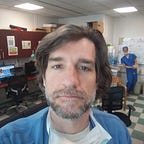For Some NYC Doctors, January is the Worst Month of the Pandemic
“This is worse than April,” Linda said.
My jaw dropped.
April was the peak of the COVID-19 pandemic in New York City, and Linda and I had been together at the center of it.
“What do you mean?” I said. “How could it be worse?”
“Because I’m all alone.”
Linda* and I are both hospitalists — we specialize in patients admitted to the hospital — and since March we’ve cared for hundreds of patients with COVID-19.
In case you were locked in a basement in 2020 (and if you were, I’m a little jealous), there was a first wave of COVID-19 infections in March and April. Washington State peaked first at 532 cases. Massachusetts peaked a little later with 3,079 cases.
New York State was hit hardest. We peaked on April 10th with 10,794 cases in a single day. New York City alone recorded 8,021 cases on April 15th.These numbers may not seem huge. But on April 15th there were only 30,000 cases in the entire country.
The absolute number of cases doesn’t tell the full story. COVID-19 patients back then were much sicker than they are now. Our case fatality rate — the percentage of infected people who die— was much higher than later in the pandemic.
Why? Some people think that we have developed new treatments, but that’s not really the case. The truth is that in March and April old people got infected, and in July and August young people did.
Older people getting infected means more death. The drastic rise in death in New York City in April is best captured in a set of graphics by the New York Times which charts excess mortality — the number of extra people who died in April 2020 compared with April in previous years.
Here’s excess mortality in some other states:
In the above graphic South Dakota has the highest excess deaths. They increased by a little over 100% in early November.
Let’s compare that with New York City in April:
What did a 675% increase in death look like from inside the Brooklyn hospital where I work? As you can imagine, it was an “all hands on deck” situation. Sub-specialists like ophthalmologists and dermatologists were being asked to do things they were not trained for.
Cardiac arrests, which normally might happen once a day, were happening every 15 minutes. Doctors sometimes had to stop doing chest compressions on a dying patient, so they could run to start resuscitating another patient, one they were more likely to save.
Along with the tragedy of all that death came a deeply unsettling feeling. It seemed like the usually rules no longer applied. There was strange sense that we had entered some bizarro alternate universe.
Let me put it like this: How often have you personally witnessed a car accident happening in real time? Maybe once or twice in your life? Now imagine if that started happening every day. Every single time you walked down the sidewalk you saw two cars crash into each other.
Would you think you were going crazy, or the world was?
That’s what April felt like in the hospital. Something was deeply wrong, but we couldn’t grasp it exactly. We talked about it over and over, trying to process it and bring logic, to make sense of the nonsensical. There were unseen forces causing destruction and death, and no one could do anything at all to stop it.
April was stressful. It was draining. But it was also kind of exhilarating.
Linda and I often huddled together in the break room at lunch, gratefully gulping fresh air after hours beneath our N95 masks. As we flapped out our gowns and put on new gloves, we felt like soldiers donning armor before striding onto the battlefield. Old friends I hadn’t heard from in years got in touch to ask how I was doing.
Then in June, the number of COVID-19 cases dwindled to almost none. Many doctors kind of forgot about the virus and went back to treating heart attacks and pneumonias.
But by November the number of cases in New York City had started rising again. This time around everything was calmer. We knew what we were doing. There was research, there was data, we had plenty of supplies.
“So why is now worse?” I asked her.
Linda reminded me of an important difference: this time around she was the lone COVID-19 doctor in our hospital. At the time we spoke, the hospital had around 12 COVID patients, enough for Linda to manage all by herself. The patients were isolated in a single unit, where Linda spent her entire day so as not to spread the virus to other staff.
“It’s so hard being over there by myself,” she told me. “Back in April we were all in it together. It was hard, it was crazy, it was exhausting, but at least we were together. Now it’s like everyone has forgotten about covid but I still have to go through it. It’s all the same as it was: people are dying and there’s nothing I can do for them. But then, when I come in here [to the break room] I can’t even talk about it with anyone. You guys are all just doing your jobs like everything is the same. You get to take care of patients that will get better and go home. And it’s like….you have no idea how hard it is for me.”
Not every doctor is Linda. Plenty of NYC nurses and doctors are back in their usual routine. But if you know someone who is caring for COVID-19 patients, maybe do something nice for them this month.
Back in April lots of people sent flowers, cooked food, and sent supportive emails and texts. This would be a good time to think about doing that again.
*Linda is not her real name.
